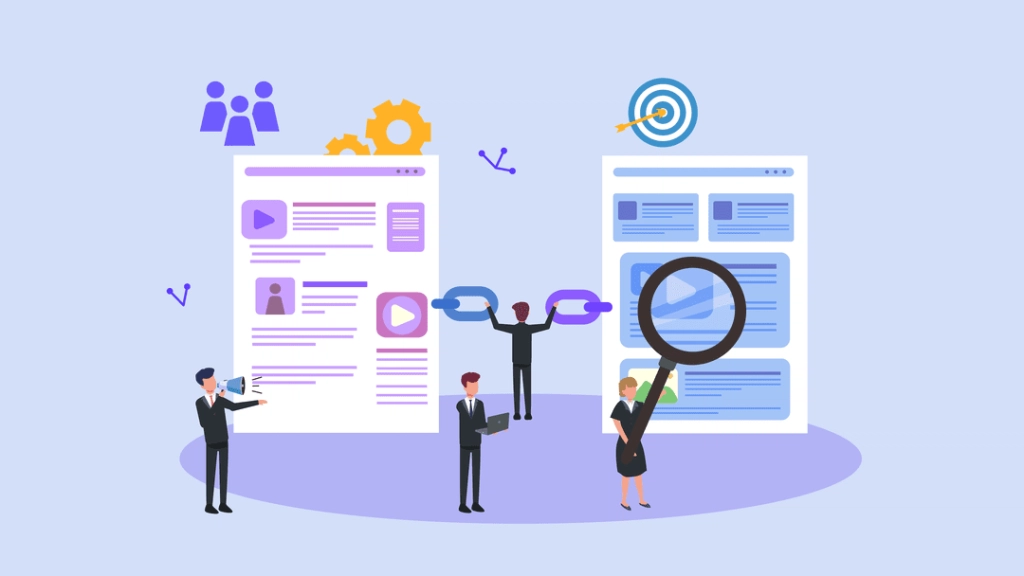Understanding internal linking and entity clustering is important in search engine optimization (SEO) since it can increase your website’s visibility and user experience.
These two linked strategies are key. Strategic internal link pointing not only enhances your website’s navigational structure but also strengthens its SEO foundation. It guides users to relevant content and boosts search engine discoverability.
This blog post covers the basics of internal linking and entity clustering. We will explore their benefits, how to implement them, and common pitfalls to avoid.
How to implement internal linking and entity clustering

What is Internal Linking
Internal links are vital hyperlinks that connect multiple pages on your site. Internal links assist search engines in understanding a website’s structure and direct readers to important pages.
Here’s a breakdown of its key components:
Role of Internal Links:
Internal links direct users through your site. They promote exploration and increase interaction with relevant content. From a technical point of view, they help search engines find and index your pages, ensuring full coverage in search results.
Distribute Page Authority:
Internal links distribute page authority on your site. This boosts the visibility and ranking of individual pages. Link from high-authority pages to lesser-known ones, which can raise their SEO and make them more competitive in search rankings.
Strategic Implementation:
An effective internal linking strategy involves careful planning and execution. Start by finding key pages that need more visibility.
Pick anchor texts that describe the linked content well. Maintain a balance to avoid too many links, and ensure to cover all your site’s content.
Best practices:
Place high quality internal links in your content and integrate them. This will improve user navigation and comprehension.
Use descriptive anchor text. It should match the linked page’s content. Avoid over-optimization to maintain a natural user experience.
Regularly audit your internal linking structure. This will let you fix issues like broken links or outdated content, keeping your linking strategy effective.
Benefits:
Internal linking offers benefits beyond improving navigation and SEO. It guides users to relevant web page content, can increase time spent on your site, and decrease bounce rates. It also adds to the site’s coherence and authority, establishing it as a trusted resource in your niche.
Advanced Techniques:
Besides standard internal linking, consider using advanced methods like hub-and-spoke models and topic clusters. These approaches organize content around central topics or pillars, allowing for better navigation and search engine visibility.

Entity Clustering: Organizing Content for Relevance and Authority
Entity clustering is a more advanced SEO technique. It organizes content around specific themes or entities. This gives clarity to both users and search engines. Here’s what you need to know:
Understanding Entity Clustering:
Entity clustering involves grouping content around distinct entities, such as products, people, or concepts. The goal is to create thematic coherence and relevance, which boost your site’s authority and visibility in search results.
Significance in SEO:
Entity clustering is crucial in SEO. It improves your site’s relevance and categorization in search engines. It helps search algorithms understand your content’s theme.
This leads to better indexing and higher rankings. Also, by showing expertise, you gain credibility, and attract more targeted traffic to your site.
Implementation Strategies:
Implementing entity clustering requires careful planning and execution. Start by identifying the main themes or entities your content will address.
Develop a plan that covers these topics well. Link-related pieces of content. This reinforces their relationships and boosts their visibility to search engines.
Tools and techniques can help find and organize content about entities. Keyword tools can find related terms. Content management systems (CMS) can help tag and categorize content well. Maps can help plan and keep the structure of your entity-based content strategy.
Benefits and Impact:
Entity clustering and internal linking work well together. They offer tangible benefits in search visibility, user engagement, and website performance. Through an integrated approach, your site can navigate the complexities of SEO and gain a competitive edge in the digital landscape.

Common Pitfalls to Avoid
Internal linking and entity clustering offer huge potential for improving your website’s SEO. However, certain pitfalls can hinder their effectiveness. Here are some common mistakes to avoid:
Avoid stuffing anchor texts with keywords. Search engines can see this as manipulative and hurt the user experience. Instead, use natural, descriptive anchor texts. They help users understand and follow search engine rules.
Balancing Quantity and Quality:
Strive for a balance in the number of internal links used on a page. Too few links may limit user exploration.
But, too many can overwhelm and dilute link value. Add internal links carefully. They should add value and relevance to the user’s journey through your site.
Make it Relevant:
Every internal link should have a clear purpose. It should guide users to content that enriches their understanding or provides more on a topic. Avoid linking to irrelevant content. This can ensure users and search engines understand the relationships between your pages.
Prioritizing User Experience:
Internal links should enhance, not hinder, the user experience. Avoid creating convoluted navigation paths or linking to broken or outdated content. Regularly audit your internal links. This will keep them effective and intact.
Avoid siloed content. Content silos lack links and shrink page visibility and reach. Make sure to link together all the right content. This will boost the coherence and authority of your site.

Understanding the Concept of Link Building and Keyword Research
Link building and keyword research are two key parts of SEO. They work together to boost your website’s visibility and search rankings. Keyword research involves finding the terms and phrases your target audience uses.
Understanding the search queries related to your industry or niche. Optimize your content to match the intent of your audience. Once you’ve done keyword research and found relevant terms, you use them in your content strategically.
This includes product pages and articles. These keywords are the foundation of your SEO. They help search engines understand if your page is relevant to a search.
Likewise, link building focuses on creating relationships between entities, such as pages on your website or external sources. Building links from reputable websites to your own signals to search engines that your content is trustworthy and authoritative.
A good table of contents also helps with link building. It has links to related pages on your site. These links improve navigation for your users. They also help search engines find and index your content well.
Conclusion
Internal linking and entity clustering are key for optimizing your website’s SEO and user experience. You can improve your search engine rankings by connecting related content. You should organize the content around key themes or entities to provide a cohesive and satisfying user journey.
Use internal linking to guide visitors through your site. It also spreads page authority and improves search engine discoverability.
Place internal links in your content with care. Use descriptive anchor texts. Regularly audit your links to ensure they work.
Mastering advanced SEO techniques requires ongoing refinement. Adapt to meet the changing needs of your site and its audience. Add internal links and entity clustering to your SEO strategy. They help you navigate the web with confidence, driving lasting growth and success for your website.
Tags



